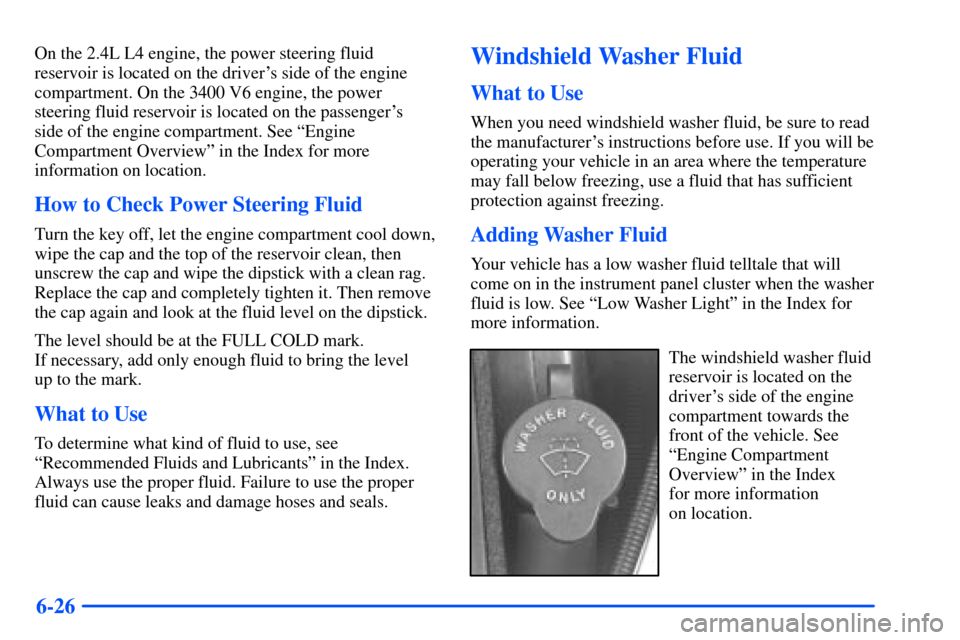Page 262 of 340
6-24 Checking Coolant
The coolant surge tank is located on the passenger's
side of the engine compartment. See ªEngine
Compartment Overviewº in the Index for more
information on location.
CAUTION:
Turning the surge tank pressure cap when the
engine and radiator are hot can allow steam and
scalding liquids to blow out and burn you badly.
Never turn the surge tank pressure cap
-- even a
little
-- when the engine and radiator are hot.
The vehicle must be on a level surface. When your
engine is cold, the coolant level should be at the
FULL COLD mark, or a little higher.
If the light comes on and
stays on, it means you're
low on engine coolant.
Page 264 of 340

6-26
On the 2.4L L4 engine, the power steering fluid
reservoir is located on the driver's side of the engine
compartment. On the 3400 V6 engine, the power
steering fluid reservoir is located on the passenger's
side of the engine compartment. See ªEngine
Compartment Overviewº in the Index for more
information on location.
How to Check Power Steering Fluid
Turn the key off, let the engine compartment cool down,
wipe the cap and the top of the reservoir clean, then
unscrew the cap and wipe the dipstick with a clean rag.
Replace the cap and completely tighten it. Then remove
the cap again and look at the fluid level on the dipstick.
The level should be at the FULL COLD mark.
If necessary, add only enough fluid to bring the level
up to the mark.
What to Use
To determine what kind of fluid to use, see
ªRecommended Fluids and Lubricantsº in the Index.
Always use the proper fluid. Failure to use the proper
fluid can cause leaks and damage hoses and seals.
Windshield Washer Fluid
What to Use
When you need windshield washer fluid, be sure to read
the manufacturer's instructions before use. If you will be
operating your vehicle in an area where the temperature
may fall below freezing, use a fluid that has sufficient
protection against freezing.
Adding Washer Fluid
Your vehicle has a low washer fluid telltale that will
come on in the instrument panel cluster when the washer
fluid is low. See ªLow Washer Lightº in the Index for
more information.
The windshield washer fluid
reservoir is located on the
driver's side of the engine
compartment towards the
front of the vehicle. See
ªEngine Compartment
Overviewº in the Index
for more information
on location.
Page 278 of 340

6-40
Any time you adjust a tire's pressure, rotate your tires,
have one or more tires repaired or replaced, or when any
work is done on your vehicle where tires are removed
you'll need to reset (calibrate) the tire pressure monitor
system. You'll also need to reset the system whenever
you buy new tires and whenever the vehicle's battery
has been disconnected.
To reset (calibrate) the system:
1. Turn the ignition switch to ON (engine not running).
2. Press and release the RESET button located inside
of the driver's side instrument panel fuse block.
The CHANGE OIL light will begin to flash.
3. Press and release the RESET button again.
The CHANGE OIL light will go off, and the
LOW TIRE PRESSURE light will start flashing.
4. When the LOW TIRE PRESSURE light is flashing,
press and hold the RESET button until the
chime sounds.
If the LOW TIRE PRESSURE light doesn't go off,
repeat the procedure. If the LOW TIRE PRESSURE
light still remains on, see your dealer for service.
The system completes the calibration process
during driving.The system normally takes 15 to 20 minutes of driving in
each of three speed ranges to ªlearnº tire pressures. The
speed ranges are 15 to 40 mph (25 to 65 km/h), 40 to
65 mph (65 to 105 km/h) and above 65 mph (105 km/h).
When learning is complete, the system will alert you after
2
-8 minutes if a tire is 12 psi (83 kPa) different from the
other three tires. Detection thresholds may be higher and
detection times may be longer on rough roads, curves and
at high speeds. The system is not capable of detection at
speeds greater than 75 mph (120 km/h).
Tire Inspection and Rotation
Tires should be rotated every 6,000 to 8,000 miles
(10 000 to 13 000 km). Any time you notice unusual
wear, rotate your tires as soon as possible and check
wheel alignment. Also check for damaged tires or
wheels. See ªWhen It's Time for New Tiresº and
ªWheel Replacementº later in this section for
more information.
The purpose of regular rotation is to achieve more
uniform wear for all tires on the vehicle. The first
rotation is the most important. See ªScheduled
Maintenance Servicesº in the Index for scheduled
rotation intervals.
Page:
< prev 1-8 9-16 17-24